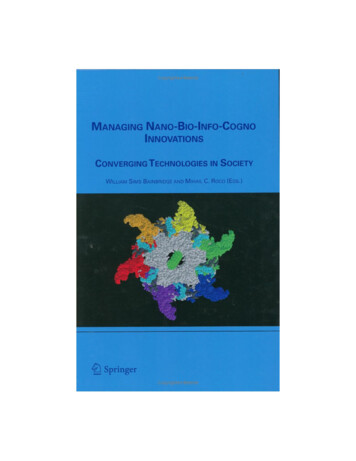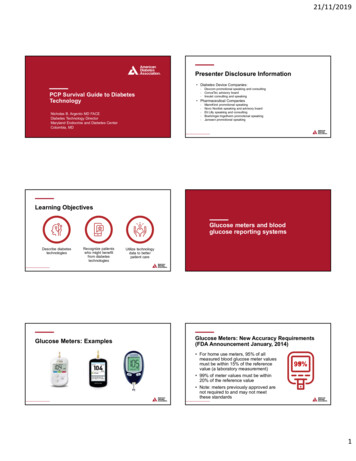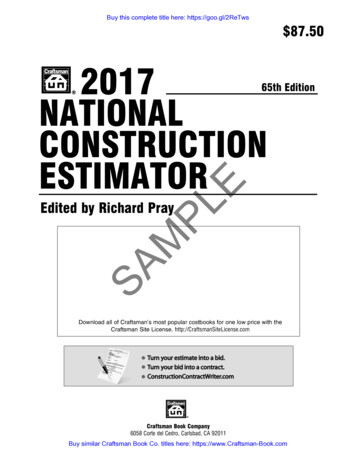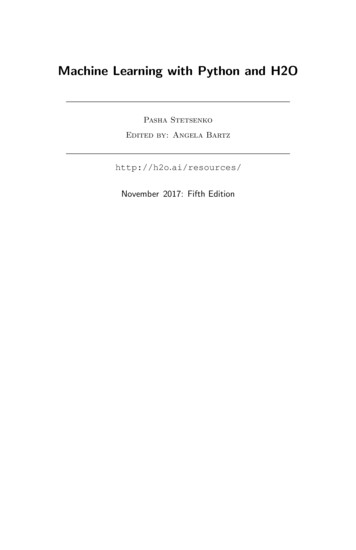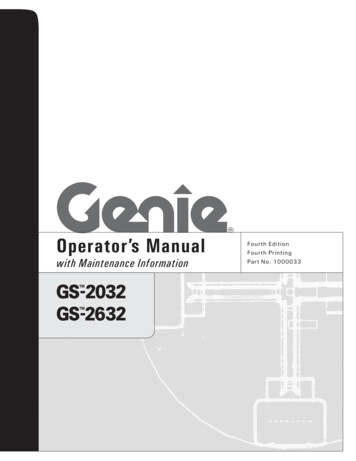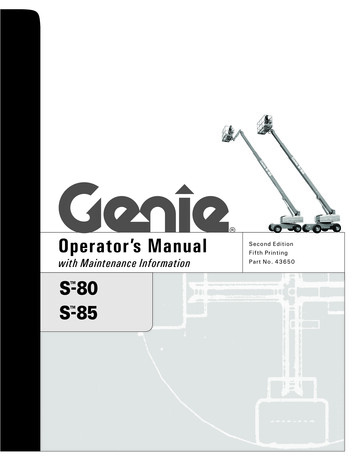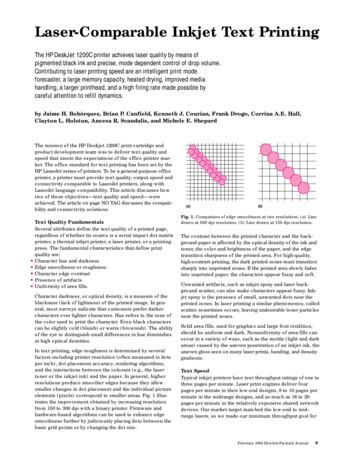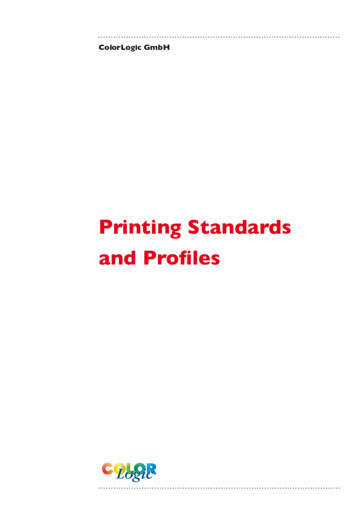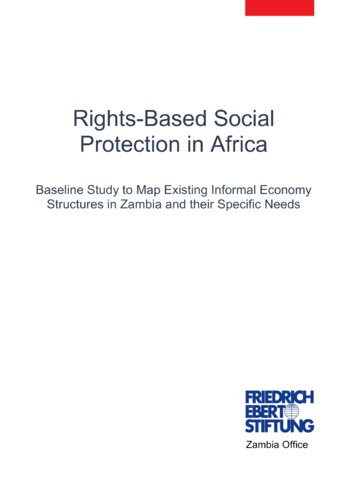
Transcription
The Friedrich-Ebert-StiftungThe Friedrich-Ebert-Stiftung (FES) was founded in 1925 as a political legacy ofGermanys first democratically elected president, Friedrich Ebert.Ebert was a Social Democrat from a humble crafts background, who had risen to thehighest political office in his country. In response to his own painful experience inpolitical confrontation, he had proposed the establishment of a foundation to serve thefollowing aims:· Furthering the political and social education of individuals from all walks of life,in the spirit of democracy and pluralism;· Giving gifted young people scholarhsips to universities; and· Contributing to international understanding and co-operation.The FES, which was banned by the Nazis in 1933, and re-established in 1947,continues today to pursue those aims in all its extensive activities.As a private cultural non-profit institution, it is committed to the ideas and basic valuesof social democracy.
Published and Copyright by:Friedrich Ebert StiftungZambia Office5583 Great East RoadP.O. Box 30554Kalundu, LusakaPhone: 260 211 rcial use of all media Published by the Friedrich-Ebert-Stiftung (FES) is not permitted withoutthe written consent of the FES. Readers are encouraged to quote or reproduce material for their ownpublications, as long as they are not being sold commercially.The findings, interpretations and conclusions expressed in this volume do not necessarily reflect theviews of the Friedrich-Ebert-Stiftung.
TABLE OF CONTENTSACRONYMS AND ABBREVIATIONS . 3ACKNOWLEDGEMENTS . 4EXECUTIVE SUMMARY . 51.0INTRODUCTION . 132.0INFORMAL ECONOMY AND CHALLENGES OF SOCIAL PROTECTION . 202.1Social Protection in Zambia . 202.2Challenges Associated with Extension of Social Security Coverage . 252.3Policy Framework and Current Approaches towards Social Security Extension . 263.0INFORMAL ECONOMY MAPPING: A CONCEPTUAL FRAMEWORK . 293.1Evolution of Concept of Informality and Statistical Measurement . 293.2Adopting the Developmental Conceptual Framework . 314.0KEY STUDY FINDINGS . 394.1Informal Economy in Zambia: Employment Structures . 394.2Informal Market Vendors: Characteristics, Business Structure and Environment . 424.3Income Levels Pertaining to Market Vendors’ Business . 454.4Social Security Mechanisms being used by Informal Market Traders . 454.5Social Security Registration and Perceptions of Formal Pension Systems. 494.6Willingness to Contribute to a Mutual Hybrid ‘Pensions’ Fund . 524.7Mapping of Key Stakeholders Supporting Informal Workers: . 554.8Livelihood Trends . 595.0SUMMARY AND IMPLICATIONS FOR POLICY AND ACTIONS . 645.1Summary . 645.2Recommendations . 685.3Conclusion . 73REFERENCES . 742
ACRONYMS AND ABBREVIATIONS7NDP-Seventh National Development PlanAVEMA-Association of Vendors and MarketeersAZIEA-Alliance for Zambian Informal Economy AssociationsCSO-Central Statistical OfficeFES-Friedrich Ebert StiftungICLS-International Conference for Labour StatisticiansICSE-International Classification of Status in EmploymentILO-International Labour OrganisationLASF-Local Authorities Superannuation FundLCMS-Living Conditions Monitoring SurveyNAPSA-National Pension Scheme AuthorityNATMAZ-National Traders and Marketeers Association of ZambiaNHI-National Health InsuranceNSPP-National Social Protection PolicyOECD-Organisation on Economic Cooperation and DevelopmentPSPF-Public Service Pensions FundSGs-Savings GroupSMEs-Small and Medium EnterprisesTWG-Technical Working GroupWCFCB-Workers’ Compensation Fund Control BoardZCTU-Zambia Congress Trade UnionsZFE-Zambia Federation of EmployersZILARD-Zambia Institute for Labour Research and Development3
ACKNOWLEDGEMENTSWe would like to acknowledge several individuals and organisations that made this studypossible. We would like to thank the FES for the financial support to this project. Weacknowledge the ZILARD Team that carried out the study. In particular, Prof. TrywellKalusopa that initiated, conceptualised and coordinated the whole study as a Team Leader.We recognise Dr. Grayson Koyi, as an alternate Team Leader and Principal Researcher, whowas responsible for the ground coordination of whole data collection process in terms ofselection of sites and actual data collection, development of methodologies for data collectionand instruments, guiding the entry and cleaning of data, report writing and assisted in theengagement of various stakeholder at all the stages of the research process. The field researchand data collection was guided by Mr. Francis J. Phiri as the field supervisor. Data entry,cleaning and analysis was done by Mr. Solomon Mwampikita (Statistician). The followingfield research assistants contributed significantly to this work in various ways: Ms. MubangaSimukanga, Ms. Bwalya Sunkuntu, Ms. Coleen Imasiku, Ms. Mercy Mwale, Mr. StanleyZulu and Mr. Julius Ngoma.We would like to thank the Zambia Congress of Trade Unions (ZCTU) for all the humanmaterial and infrastructural support. We are also indebted to the Central Statistics Office(CSO), The Ministry of Labour & Social Security, NAPSA and ILO for the support in thedata collection and their expert input to the whole research process. We are grateful toAZIEA and AVEMA for the assistance in gaining entry to the difficult research sites for datacollection. The actual participants that answered to our questionnaire and interviews in theinformal economy are greatly appreciated.4
EXECUTIVE SUMMARYThe informal economy plays a critical role in the lives of millions of individuals in bothurban and rural settings across the globe. It provides livelihoods, employment andentrepreneurship opportunities. Initially regarded as a passing phenomenon, the informaleconomy has established itself as a significant contributor to the national economy.Broadly defined, the term informal economy refers to all economic activities by workers andeconomic units that are not covered or insufficiently covered by formal arrangements andsocial protection. However, despite its importance, the informal economy sits uncomfortablywithin national policy in Zambia, and it has historically been excluded from social securitycoverage. Nearly all informal wage earners are excluded from the two largest social securityschemes, National Pensions Scheme Authority (NAPSA) and Workers Compensation FundControl Board (WCFCB). This raises troubling questions regarding the informal economyand social protection coverage in Zambia.Hence, the problem investigated was twofold: establish the nature and functionality ofexisting support organisations in the informal economy, with special reference to markettraders’ associations, and analyse market traders perspectives regarding the current socialprotection mechanisms to the informal economy with a view of proposing innovative socialsecurity policy intervention models that would be appropriate to the needs and circumstancesof informal workers/market traders.AIMS OF THE STUDYThe study sought to establish a baseline of existing informal economy support institutionsand informal economy associations and examine the current social protection mechanisms tothe informal economy with a view to proposing effective social security policy interventionsthat would sustain the informal economy workers. The specific study aims were to:· Identify stakeholders supporting informal workers in the five targeted provinces;· Identify social security mechanisms that informal workers are using in the targetedprovince;· Obtain basic information on the nature of the informal economy in Zambia withparticular reference to the following:o Livelihood trends in the informal economy in the five provinces;5
o Key risks/contingencies faced by workers in the informal economy;o Income levels pertaining to market vendors’ businesses;o Willingness to contribute to a pension fund and amount willing to contribute;o Perceptions of formal pension systems among workers in the informaleconomy.METHODOLOGY AND STUDY SITESThe study employed critical realist philosophy of science in its explorations. The fieldworkwas carried out during August and October 2019 in five Zambian provinces, namely:Luapula, Copperbelt, Southern, Lusaka and Eastern. These sites were selected by thecommissioners of the study. However, they represent (except for Luapula) provinces with thehighest concentration of informality in Zambia (CSO, LFS 2018). The study combinedmethods of data collection using qualitative and quantitative techniques: the main methodsinvolved desk reviews, key informant interviews, and survey questionnaire. The actualsample size for this assignment was 1,023 participants. The target population was all theinformal market traders in the five regions selected as multi case-studies.KEY FINDINGS1. Informal economy associations are strong at national level although grassroots’ levelstructures remain nascent and in need of capacity building to ensure cohesionThe study established that there are mainly two nation-wide informal economy associationsnamely: Association of Vendors and Maketeers (AVEMA) and Alliance for ZambianInformal Economy Associations (AZIEA) although the National Traders and MarketeersAssociation of Zambia (NATMAZ) has recently been established and on the rise. However,there are other local level associations that are spread across the five provinces; but theselargely comprise members of one of the two national-level informal economy associations.These two associations have strong national level structures although grassroots levelstructures remain nascent urging the need for more capacity building of these institutions tofoster cohesion, inclusiveness and unity of purpose.6
2. Informal economy actors are heterogeneous and cut across a wide spectrum butinformal market traders are the single most visible actor, particularly in urban areasThe study establishes that the structure of the informal economy in Zambia cuts across a widespectrum of economic activities. These can be seen as ranging from fishing to mining; smallscale manufacturing to construction; from service delivery mainly in taxis and commuter bustransportation to small shops, barbershops, hair saloons, retail outlets and car repairs; fromsubsistence farming to domestic work, vending and hawking; from ‘marketeers’ sellingperishable goods, new and second hand clothes to money exchangers; from those with somecrafts or skills like mechanics, saw millers, plumbers, bricklayers, electricians, painters,artists, watch repairers, musicians, and photographers to shoe makers, tailors and carpenters.In short, heterogeneity is the word that best describes almost all aspects of the informaleconomy in Zambia - as almost every sector of the Zambian economy has an informalcomponent.3. Most informal market traders are own account workers, and tend to be female, relativelyyoung but mostly with some secondary level of educationThe study establishes that a great majority of traders surveyed (90 percent) own their ownbusiness, and in most cases (79 percent) the owner is the sole employee. Besides, most of thetraders surveyed are female, relatively young, and have secondary education. Women accountfor over two-thirds of the traders in Southern, and over 60 percent in Copperbelt and EasternProvinces. Over half of the traders surveyed were aged between 25 to 44 years. Thus,women, the young and those without tertiary level of education have been the most affectedby limited formal employment opportunities in the selected provinces in Zambia. In thissense, market vending affords them stable income to work their way out of poverty anddeprivation, and has allowed them — especially the women — to provide for their families.Market trading is, therefore, a major means of reducing household poverty and vulnerability.Extension of social protection coverage to such households would ensure that suchhousehold’s future cash flows are guaranteed.4. The operational environment of market traders and own account workers tends to besusceptible to harassment by local council officialsAbout two-thirds (73 percent) of the vendors surveyed said they faced harassment fromcouncil officials who repeatedly asked for levies. Follow-up discussions suggest it is not thepayment of levies that they find unfair but the modalities of levy collections that sometimes7
are carried out by intermediaries on behalf of local council officials. The specific needexpressed was that of protection from intermediaries that collect levies at the market withoutthe established regularities of collections.5. Income levels are quite low among informal workers and market traders, with anaverage monthly profit of about K1, 700.With regards to income levels pertaining to certain businesses, the study establishes thatwhile informal trading businesses are not especially costly to operate, the profits are alsoquite low. The average monthly turnover of running a business in the open market place isabout K2, 939.39 (approximately US 230), with a minimum of K1, 414.29 (US 110) and amaximum of K5, 125.29 (US 400). About half of the vendors reported an average monthlyprofit of K1, 785.12 (US 140).6. Majority of informal market traders surveyed (80%) relied on Savings Group, Ichilimbaand Kaloba as a form of informal social securityThe study found that majority of informal market traders participating in the study (80percent) relied on Informal Saving Groups, Ichilimba and Kaloba as a strategy to capitalise,and to insure their business and to smoothen household consumption. Together, Savingsgroups, Ichilimba and Kaloba constituted about 80 percent of the forms of social securitybeing used by informal market traders. The least forms of social security (5 percent) wereprivate and NGO-supported social security mechanisms while Government supportedmechanisms (such as food packs, citizen’s economic empowerment programmes) constitutedabout 10 percent.Savings Groups, Ichilimba and Kaloba are the main forms of social security being usedamong informal market traders and the contribution frequency are so designed as to rangefrom daily to monthly contributions. Given that income from sales varies, contributionfrequencies ranging from daily to monthly provide members a secure place to save, theopportunity to borrow in small amounts and on flexible terms, and affordable basic insuranceservices.Available information suggests that there are currently 331,704 SGs members in Zambia witha gender distribution of 72 percent female and 18 percent male. The popularity of theinformal group savings model could be harnessed to buttress efforts at extending socialsecurity to the informal economy. In this regard, a hybrid mutual fund that includes a8
pension’s fund component would stand in better stead to succeed than compelling informalmarket traders to register with existing pensions systems.7. Willingness to contribute to Mutual Hybrid Fund by informal market traders wassignificantly high, 86%The willingness to contribute to such a fund among participants was significantly high at 86percent. The responses were generally on the high side: Copperbelt (96 percent); Luapula (87percent); Eastern (86 percent), Southern (81 percent) and Lusaka (78 percent). Majority ofinformal market traders (88%) preferred monthly contribution towards mutual hybrid fund.The modal amount informal market traders were willing to contribute per month towards amutual hybrid fund was K50; although the mean average was coming to K115 per month.Majority of informal market stated a willingness to pay K50 monthly, with a median amountof K51 and an average (mean) amount of K 115 per month. The K50 per month amount, mostwere willing to contribute, corresponds to 5 percent of median monthly income and 2 percentof mean monthly income reported earlier.8. The top most need expected of the fund benefit package was provision of credit/softloansThe study established that preferred benefits expected of a mutual hybrid fund shouldinclude:· Access to credit/soft loans ( also referred to as withdrawal benefits)· Funeral cover/grant· School fees· Medical expenses/health cover· Mortgage/building materials· Old-age pension· Child/family benefitsEvidence from the responses confirmed that informal market traders are more concerned bytheir most immediate needs, particularly access to credit, funeral cover, school fees andmedical aid. It would therefore be prudent for the hybrid mutual fund to build in thesebenefits in the package.9
9. The general perception of existing formal pension’s schemes was negative with 60% ofthe view that formal pension schemes did not meet their specific needsAbout three-quarters of the traders reported that they were not registered with any existingpension fund, although they would be willing to contribute to a ‘hybrid mutual fund’ despiteearning relatively little money.10. Market vendors’ business performance/income during the year tends to be highbetween May-August but low between Oct-February, although they preferred monthlycontributions towards mutual hybrid fundThe study established that the level of income among market traders tends to be on the highside between the months of May and August, then assume average proportions aroundSeptember and dips between the months of October and February. Most fundamentally, thiscash-flow pattern seems to generally correlate with the weather patterns and timing of foodcrop harvest from the farming community. This seasonality may have implication fordetermining the contribution frequency. Where a seasonal contribution is preferable, thismay have to be in the months of April to September. The majority of market traders,however, preferred the frequency of paying for the contribution monthly (JanuaryDecember).11. The livelihood patterns and well-being of market vendors over the last 3-5 years hadremained static with no significant improvement reportedMarket traders were also asked to self-report their livelihood trends in the last three to fiveyears in relation to their income, assets, food security, resilience and well-being. Generally,most market vendors felt that their livelihood status had remained more or less the same overthe last 3-5 years. About 41 percent reported that income levels had not changed over the l
The Friedrich-Ebert-Stiftung The Friedrich-Ebert-Stiftung (FES) was founded in 1925 as a political legacy of . Seventh National Development Plan AVEMA - Association of Vendors and Marketeers . and Workers Compensation Fund Control Board (WCFCB). This raises troubling questions regarding t
